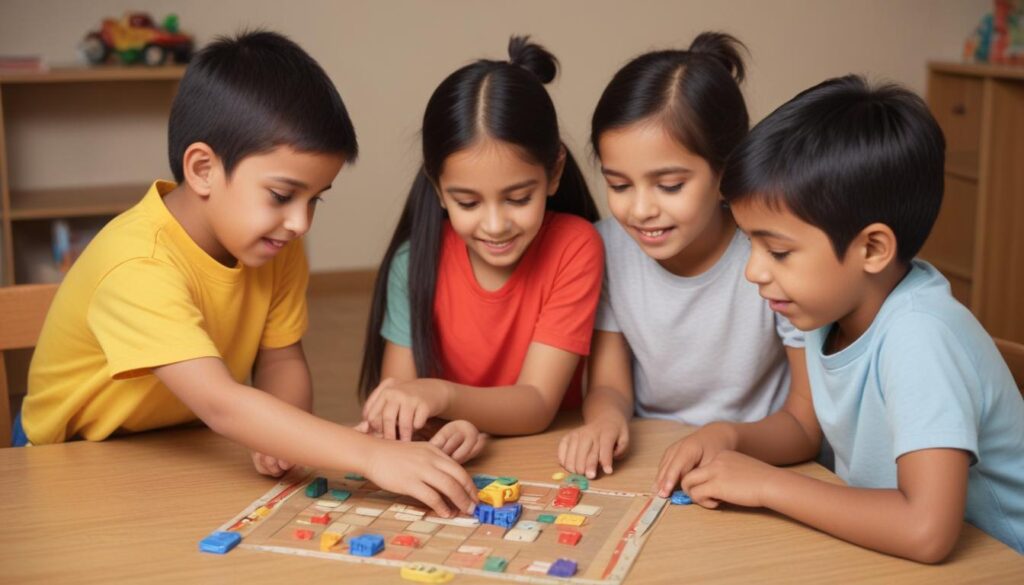Introduction
Today’s Gen Z cannot understand the joy of our childhood games. Our childhood games were precious. We were happy playing games. The simplicity and joy in our childhood games were amazing. The childhood games which I bring for you is so nostalgic.
1. Alphabet
Number of players: from 2.
Time: 30–90 minutes.
Age: 10+.
1. Each participant draws a table on a piece of notebook paper. The column headings are: boy’s name, girl’s name, plant, animal, city, profession, something of your choice, glasses. Usually the set of topics is standard, but you can change it if you wish.
2. The driver lists the letters of the alphabet to himself. When one of the players says: “Stop”, he must name the one that sounded in his head last.
3. Participants are given one minute during which they must fill in their signs – write words that begin with the guessed letter and relate to the topic indicated in the header: plant, animal, and so on.
For example, if the number “B” is rolled, the answers could be: Vera, Volodya, Venus flytrap, wolf, Volgograd, doctor, eyelid.
4. When the minute is up, players must take turns reading their notes. Each correct word is worth 10 points. If the participants have a match, they get 5 points each. If a column is left blank, nothing is given for it.
2. Rat
Number of players: from 3.
Time: 5–20 minutes.
Age: 5+.
We played “Rat” (or “Sifu”) during recess. The rules are as follows:
1. The leader gathers a crowd around himself and commands: “Start.” The participants run off in all directions. At this point, the water must throw a “rat” at one of them – a toy mouse on a string. We kept it in our classroom.
2. If it hits someone, that person must try to quickly throw the toy at another participant. Otherwise, he or she will become a “rat”.
You can play endlessly, but we usually finished when we heard the bell for class. The one who was the last one, at the next break, tried to get rid of the humiliating status as quickly as possible and quickly throw the “rat” at another person.
3. Peaks and farads
Number of players: 2.
Time: 10–30 minutes.
Age: 8+.
1. Everyone thinks of a four-digit number. We had an agreement that the same digit should not be repeated. That is, we could take, for example, “2967”. But there is another option – with repeating digits. In this case, the participant can think of either “2244” or “2222”.
2. The players take turns trying to guess each other’s numbers. If the digit in the number is guessed and is in its place, you need to say: “Farad”. If not, “Pika”.
For example, if your opponent guessed “3456” and you guessed “3546,” he must say “2 farads, 2 spades.” When you get the answer “4 farads,” you win.
You can’t cheat! And there’s hardly any point in it. After all, when you go through possible combinations, you realize that something doesn’t add up. The error is quickly discovered.
4. Banks

Number of players: from 3.
Time: 20–60 minutes.
Age: 8+.
A tin can was placed on the ground. A leader was appointed who had to guard it. Then the rules were as follows:
1. Players find sticks and throw them at the jar one by one, trying to knock it down.
2. As soon as someone manages to do this, the participants run across the entire field for their sticks. The leader’s task at this point is to put the can back. And then have time to touch any player before he runs beyond the previously designated line.
When retreating, participants can try to knock down the can. Until the leader puts it back, he cannot tag anyone. The one he managed to hit takes his place.
5. Fight with soft toys
Number of players: 2.
Time: 10–40 minutes.
Age: 4+.
The rules are simple:
1. Participants distribute among themselves the projectiles – soft toys without sharp and protruding noses and eyes. The small leather gorilla was always in special demand – it flew hard.
2. Players sit at different ends of the room, put toys next to each other. And the battle begins!
Important to remember:
You can hide behind furniture.
You can’t step forward – not even one step.
It is forbidden to take away or steal shells.
6. The sea is worried once

Number of players: from 3.
Time: 10–20 minutes.
Age: 4+.
1. You need to choose a leader. He must turn away from the others and recite a poem:
The sea is worried once,
The sea is worried twice,
The sea is worried three times,
The sea figure freezes in place.
Usually we replaced the last words with something else: “animal figure”, “clown figure”, “funny figure”. It reached the point of absurdity. In general, we gave free rein to our imagination.
While the leader recites the rhyme, everyone moves chaotically. As soon as he finishes and turns around, you need to freeze, impersonating someone: a fish, seaweed, a starfish, and so on.
2. The host must guess who exactly the players are showing. He can approach any person and ask them to move. If someone else moves or laughs at this moment, they lose.
7. Wall
Number of players: from 2.
Time: 5–20 minutes.
Age: 8+.
1. You need a flat wall and a flat surface under the wall. In our case, this function was performed by a span in the school corridor.
2. You agree which of your friends will go first, which will go second, and so on. The easiest way is to draw lots using “tsu-e-fa”.
3. The first participant throws a coin so that it hits the wall and falls to the floor. It cannot be moved.
4. The second person must try to throw his coin so that it also bounces off the wall and lands as close to the first as possible.

